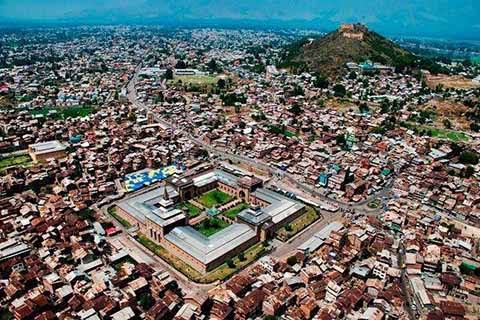Naya Kashmir’s Smart City Dreams: Boon or Bane for Kashmir Residents?
By: Javid Amin
The ambitious Smart City project in ‘Naya Kashmir,’ with an estimated cost of ₹3,550 crores, promises a transformative urban experience. Designed to enhance infrastructure, improve public services, and boost the overall quality of life, such projects are a beacon of progress. However, the implementation of this project has also exposed significant challenges, particularly affecting the city’s vital roadways. This article delves into the dual reality of the Smart City initiative in Kashmir, exploring both its potential benefits and the unintended consequences it has had on urban life.
The Vision of the Smart City Project
The Smart City project aims to modernize urban areas through the integration of technology, sustainable practices, and improved public services. Key components include:
- Infrastructure Development: Upgrading roads, bridges, and public transport systems to ensure smooth and efficient mobility.
- Digital Integration: Implementing advanced IT solutions for better governance and public service delivery.
- Environmental Sustainability: Promoting green spaces, energy-efficient buildings, and waste management systems.
- Economic Growth: Fostering business opportunities and improving employment rates through enhanced urban facilities.
The Reality on the Ground
Despite its visionary goals, the execution of the Smart City project in Kashmir has faced several obstacles. The most notable impact has been on the city’s road infrastructure, which has, paradoxically, been choked by the very development intended to improve it.
Road Congestion and Infrastructure Strain The construction activities associated with the Smart City project have significantly disrupted daily life. Key issues include:
- Traffic Congestion: Extensive roadworks have led to severe traffic jams, with major arteries of the city often blocked. Commuters face long delays, which impacts productivity and quality of life.
- Road Closures: Frequent closures of roads for construction have diverted traffic to narrower, less equipped roads, exacerbating congestion.
- Safety Concerns: Incomplete construction sites and poorly managed traffic diversions pose safety hazards for both pedestrians and drivers.
Year-by-Year Breakdown of Tariff Increases To fully grasp the economic impact on residents, it’s essential to look at how power tariffs have increased over the past decade. Each hike not only reflects rising costs but also underscores the growing financial burden on the public.
| Year | Tariff Increase (%) | Explanation |
|---|---|---|
| 2013 | 5% | Initial phase of infrastructure upgrades |
| 2014 | 7% | Increase in operational costs and maintenance |
| 2015 | 6% | Introduction of advanced metering systems |
| 2016 | 8% | Expansion of the power grid |
| 2017 | 5% | Inflation adjustment and infrastructure costs |
| 2018 | 10% | Major upgrades to power plants |
| 2019 | 6% | Enhanced service delivery and reliability measures |
| 2020 | 7% | Increased fuel costs and operational expenses |
| 2021 | 9% | Comprehensive modernization projects |
| 2022 | 8% | Final phase of Smart City integrations |
Public Discontent and Political Silence Despite the obvious disruptions, there has been a noticeable silence from political leaders. Many residents feel abandoned by their representatives, who seem more focused on the broader vision of the Smart City rather than addressing immediate issues.
- Lack of Communication: There has been inadequate communication from authorities regarding the progress and timelines of construction projects.
- Unaddressed Grievances: Public complaints about road conditions and traffic problems have largely been ignored, leading to frustration and resentment.
- Political Inaction: Despite the clear public discontent, political leaders have remained largely mute, failing to advocate for the citizens’ immediate needs.
Improvements and Shortcomings
Infrastructure Upgrades In fairness, the Smart City project has led to several improvements:
- Better Public Transport: Modernized bus services and new routes have improved public transport connectivity.
- Enhanced Public Spaces: The development of parks and recreational areas has contributed to a more livable city environment.
- Digital Services: Implementation of digital platforms for public services has streamlined administrative processes.
Persistent Issues However, several critical issues remain unresolved:
- Power Cuts: A decade ago, residents faced up to 8-10 hours of power outages daily. Today, despite infrastructure upgrades, power cuts still occur for 5-8 hours, highlighting persistent energy management problems.
- Road Safety: Incomplete and poorly managed construction sites continue to pose significant hazards.
- Economic Strain: The continuous rise in power tariffs and the costs associated with disrupted transport routes have added to the financial burdens of the public.
Conclusion The Smart City project in ‘Naya Kashmir’ is a classic example of the double-edged sword of urban development. While its vision promises significant long-term benefits, the immediate impact has been disruptive and challenging for residents. The key to balancing these outcomes lies in better project management, improved communication from authorities, and a more proactive stance from political leaders in addressing the concerns of the public.
Disclaimer: The data and statistics presented in this article are based on available information from various sources. While every effort has been made to ensure accuracy, discrepancies may exist due to evolving circumstances and updates. Readers are encouraged to verify details from official channels and exercise discretion in interpreting the information.


